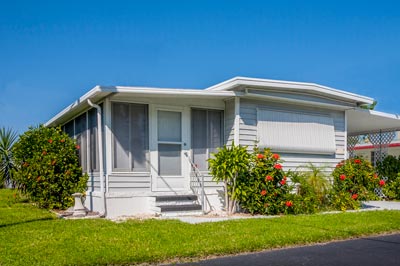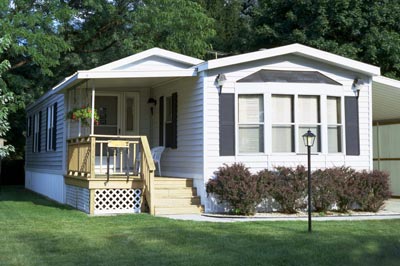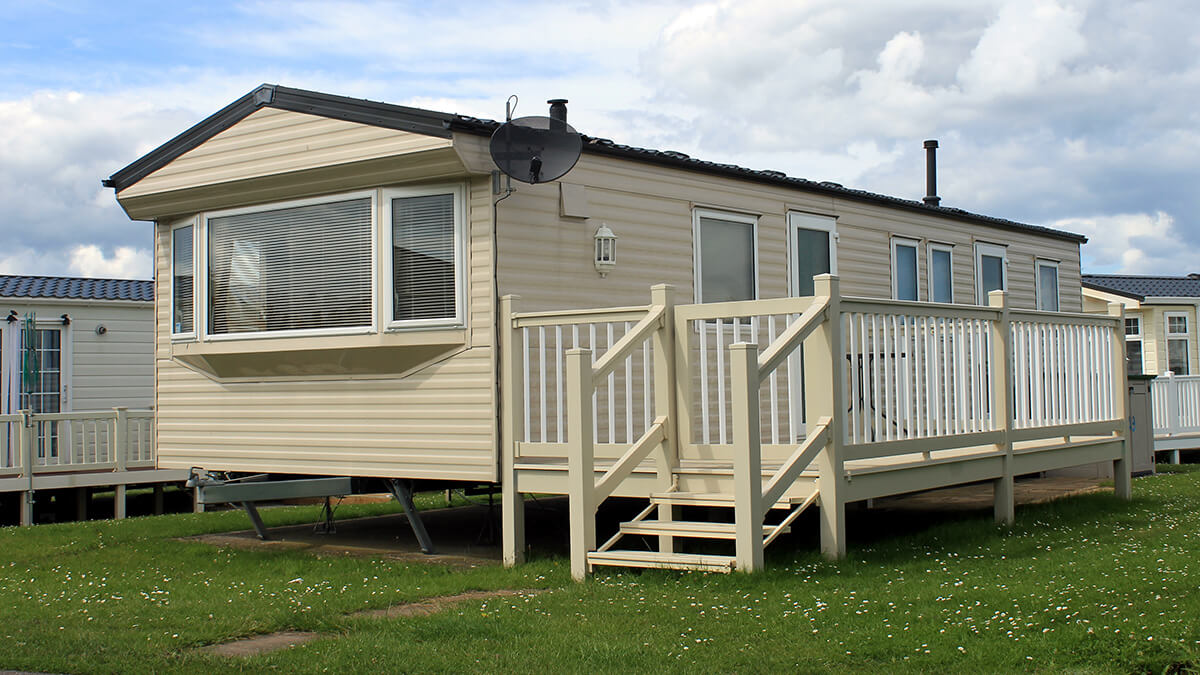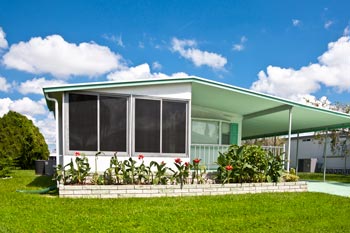Mobile home siding cleaning
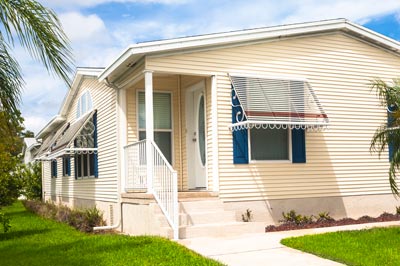
Regular maintenance will keep your siding looking new and lasting longer. Why is it so important to regularly maintain your siding? Like the skin on your body, there are two main purposes that siding fulfills: appearance and protection. It protects your home against natural elements and pests, adds stability to the frame of your home, helps insulate and it also adds character to the outside of the home.
Although there are several different types of siding you can choose from for manufactured homes, the three most popular include metal siding, like aluminum or steel, vinyl siding or a natural wood siding. And each kind of material needs to be maintained differently.
Washing
Give your home a good washing for a fresh new look.
Note: Don't wash wood siding. Heavy exposure to water might result in decay, chipping, bowed or expanded panels, disintegration or shrinkage. Read below to learn about proper maintenance for wood siding.
- Make sure you close all the windows, doors and vents.
- Cover anything on the house you don't want to get wet. Use plastic bags and tarps with duct tape to cover bushes, outdoor furniture and light fixtures.
- Attach a soft car-washing brush to your garden hose and wash off the dirt.
- Remove tree sap and any other stubborn stains. First soak the sap with raw linseed oil, mineral spirits, or auto bug and tar remover. Let stand until soft. Wipe with a clean cloth.
- You can use household detergent to clean the siding or purchase a cleaning compound specifically for your siding material. Several varieties are available at manufactured home supply stores.
- Wash your siding from top to bottom to keep the lower area wet, preventing detergent lines.
- Rinse off the cleaner. Attach a spray nozzle to your hose to increase water pressure
- Dry the siding with a towel from the top down.
Vinyl Siding
- Don't rely on a rainstorm to keep your siding clean. Give it a good cleaning at least once a year to keep sediment and grime off its surface.
- Replace any damaged panels. New panels are quick and easy to install.
- If your vinyl siding has a wood grain or pebble finish, it will hold dirt and require more frequent washing.
- If you do not have rain gutters, your house will need more frequent cleaning.
- Rubbing compound scratches vinyl surfaces.
- Vinyl siding is brittle in very cold weather. Be careful not to hit or strike it, or it might shatter.
Keep grills from vinyl. Exposing the vinyl to intense heat will melt the siding.
You might think that a paint job would be an inexpensive and easy solution to make faded vinyl siding look like new again. But paint does not hold well to vinyl's surface because it continuously changes with the weather. Vinyl soaks up heat causing expansion and contraction as temperatures rise and fall. Instead of a short-term painting job, consider replacing your siding altogether. Check with a several retailers to see the variety of colors and textures to choose from. Ask them about lifetime warranties or guarantees that they offer.
Wood Siding
Cedar, Cypress and Redwood sidings are popular siding choices that offer natural beauty to the outside of a home. But wood siding requires more upkeep than most siding because of its natural surface. With regular maintenance and care, you can prevent damage and keep your wood siding looking beautiful for several years.
- Caulk any joints, holes or cracks with a paint-able caulk. Seal the bottom of the panels and any chips.
- Paint or stain the wood every four years. Check the manufacturer's guidelines to see what kind of paint or stain works best with the wood on your home.
- Keep an eye out for critters. Birds, insects and rodents love to make a home or a meal out of wood siding.
- Keep sprinklers away from the home. Heavy exposure to water might result in decay, chipping, bowed or expanded panels, disintegration or shrinkage. Wood siding resides best in dry regions
- Check the paint for flaking and re-cover any exposed surface.
Aluminum Siding
Keep aluminum siding looking like new with a regular cleaning every six months to prevent oxidation and/or corrosion over time. For metal siding, oxidation and corrosion are common problems that wear and tear at the outside of your home. Taking care of these problems as soon as they occur could save you from having to replace your siding altogether.
Corrosion
Corroded areas leave dark spots on the siding. These are caused by moisture being exposed to the metal surface for extended periods. Check for rust-colored stains in places that tend to stay wet longer, such as under eaves or recessed entryways. If you find corroded areas, be sure to get rid of the spots before they spread further. For both aluminum and steel siding, sand out the corrosion blisters down to the bare metal, then spot prime with an anti-rust primer.
Oxidation
Oxidation leaves a white chalky film on the siding that can dull the exterior of your home. Keep your siding clean to prevent oxidation from forming. If your siding looks faded from oxidation, contact a professional manufactured home washer. A professional can clean your house in less than an hour with high-pressure hoses.
Scatches
Keep a minor scratch on your metal siding from becoming a major problem.
- Lightly rub the scratched area with a fine rubbing compound. This will remove dirt, grease and loose paint.
- Rinse with water and dry.
- Cover larger areas with a primer coat to improve to help prevent the formation of rust. Allow to dry.
- Use a small brush and cover the scratch with touch-up paint. Apply as many layers of paint as you need to make the scratch less noticeable. Allow drying time between coats, and allow two weeks for the paint to completely harden.
- Use a fine polishing compound to blend the area into the surrounding paint. Apply a coat of oil-based wax to the entire area.
Painting Metal Siding
Apply a fresh coat of paint to the siding of your home to keep it looking like new. If you need to paint just one panel, consider taking that panel to an auto body shop to be painted. They should be able to match the color. If you plan to paint the whole exterior of the home and want to tackle the project yourself, wait for a calm and overcast day to paint. Paint needs to dry slowly and the sunlight and wind will only speed up the drying process.
Prepare to paint:
- Thoroughly wash the exterior of your home
- Repair any dents.
- Caulk any cracks or holes along the panels, around corners or around windows with a paint-able caulk.
- Cover everything you don't want painted (windows, doors, the roof, etc.) with newspapers, drop cloths, tarps or masking tape. It's much easier to cover these areas beforehand than to remove paint later.
Before you're ready to apply an oil-based metal paint primer, the siding needs to be completely dry. Mix one gallon of the oil-based paint primer with one pint of paint thinner. Tint the primer to a lighter shade of the paint color you choose. The primer will help the new paint adhere to the surface and provide an extra color coat. Let the primer dry completely before adding the next coat of paint.
Use an acrylic-based, latex exterior house paint over the primer. A high volume of acrylic resin in the paint will make the paint job last longer. Invest in premium paint, brushes and roller covers. Bargain paint is no bargain if you're looking for better coverage, longer wear and a more washable surface.
How much paint do I purchase?
To compute the amount of paint needed, multiply the height of the house times the entire perimeter. Do not subtract for windows because this area will roughly equal the trim, eaves and soffits. Divide the total square footage by the number of square feet per gallon cited on the label of the paint.
